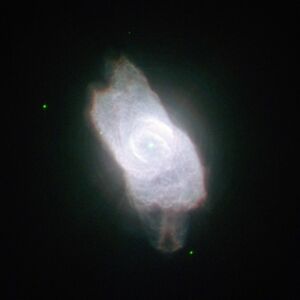Astronomy:NGC 6572
| Emission nebula | |
|---|---|
| Planetary nebula | |
 | |
| Observation data: J2000 epoch | |
| Right ascension | 18h 12m 06s[1] |
| Declination | +06° 51′ 13″[1] |
| Apparent magnitude (V) | 9. p[1] |
| Apparent dimensions (V) | 0.1 arc min[2] |
| Constellation | Ophiuchus |
| Physical characteristics | |
| Radius | 0.05 ly |
| Designations | IRAS 18096+0650, PK 034+11 1, PN VV' 370, AG+06 2201, JCMTSE J181206.2+065114, PLX 4174.00, PPM 165362, BD+06 3649, JCMTSF J181206.2+065114, PLX 4174, RAFGL 5206S, EM* CDS 964, 2MASX J18120627+0651129, PN ARO 7, SCM 192, GCRV 10650, NSV 24329, PN G034.6+11.8, WB 1809+0650, HD 166802, NVSS J181206+065112, PN VV 159. |
NGC 6572 is a planetary nebula with magnitude 8.1, easily bright enough to make it an appealing target for amateur astronomers with telescopes. NGC 6572 is a young planetary nebula. NGC 6572 began to shed its gases a few thousand years ago. Because of this, the material is still quite concentrated, which explains its abnormal brightness. The envelope of gas is currently racing out into space at a speed of around 15 kilometres per second. As it becomes more diffuse, it will dim. It is located within the large constellation of Ophiuchus (the Serpent Bearer) and at low magnification, it will appear to be just a colored star, but higher magnification will reveal its shape. NGC 6572 was discovered in 1825 by the German astronomer Friedrich Georg Wilhelm von Struve. According to several sources such as Sky & Telescope, this object received the nicknames Blue Racquetball, Emerald Nebula, Green Nebula, Turquoise Orb.[citation needed]
The central star of the planetary nebula has a spectral type of Of-WR(H).[3]
References
- ↑ 1.0 1.1 1.2 "SIMBAD Astronomical Database". Results for NGC 6572. http://simbad.u-strasbg.fr/simbad/sim-basic?Ident=ngc+6572.
- ↑ "The Interactive NGC Catalog Online". Results for NGC 6572. http://spider.seds.org/ngc/ngc.cgi?NGC+6572.
- ↑ González-Santamaría, I.; Manteiga, M.; Manchado, A.; Ulla, A.; Dafonte, C.; López Varela, P. (2021). "Planetary nebulae in Gaia EDR3: Central star identification, properties, and binarity". Astronomy & Astrophysics 656: A51. doi:10.1051/0004-6361/202141916. Bibcode: 2021A&A...656A..51G.
External links
- A Dazzling Planetary Nebula — ESA/Hubble Picture of the week.
 |

